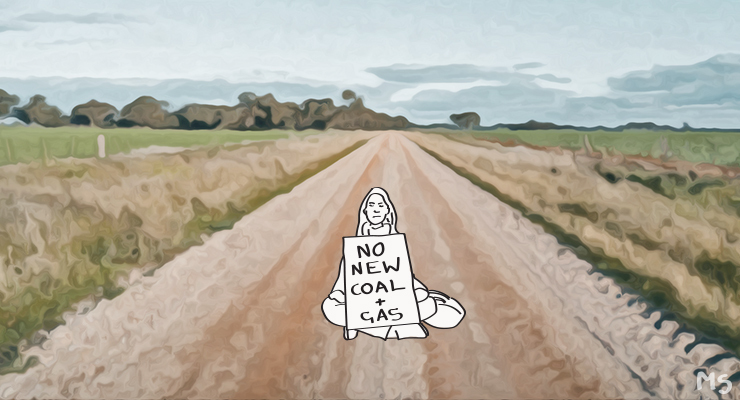
When Extinction Rebellion (XR) activists glued their hands to the perspex cover of a Picasso painting at the National Gallery of Victoria, the predictable result was some short-lived media coverage and a rash of righteous tut-tutting by offended art lovers and media commentators.
It happened only a week ago, but how many people remember — or even knew — what the protest was about?
Using art exhibits to make a political point is becoming increasingly common. In July protesters against the oil industry pasted paper over a Constable painting in London’s National Gallery before gluing themselves to the frame. And last Friday others threw tomato soup at Van Gogh’s Sunflowers in the same gallery and glued themselves to the adjacent wall.
Of course, such actions make the news. But do disruptive publicity stunts serve any useful purpose? Or do they simply risk alienating the public and potential supporters?
Think no further than the stunt by PETA to barbecue a fake dog in the Sydney CBD in 2019 as part of an international campaign against eating red meat. It predictably saw outraged headlines around the world, but with the focus largely on the crassness and pointless shock value of the street theatre rather than its supposed purpose.
So the fundamental question is, do such stunts actually help drive real change? In a startling analysis of Extinction Rebellion (XR) in the UK, respected campaign expert Chris Rose (a former Greenpeace leader) unfavourably compared XR’s high-profile stunts and exaggerated messaging with the grassroots campaigning by teenage activist Greta Thunberg.
He says XR, for its own reasons, wants to drive a rebellion against government before getting around to cutting carbon, and that its pathway is not obvious from the topline narrative of climate emergency: “It’s likely that most of those who flocked to support XR in 2018 and 2019 had no idea of the revolutionary fine print and were simply motivated by alarm about climate change.”
Rose says that, by contrast, Thunberg’s part of the movement sticks closely to the science as represented by the IPCC.
While XR describes itself as “strictly non-violent and reluctant law-breakers”, it is very conscious of the risk of adverse opinion, as highlighted by some of the FAQs on its website:
- Aren’t you just a bunch of law-breaking anarchists or economic terrorists or eco-fascists? Why should anyone listen to a bunch of people who actively try to get criminal records?
- Aren’t you alienating a lot of the people that you should be working with?
- Aren’t you just going to get a lot of inexperienced people arrested, in prison, and with criminal records, so that you hit the headlines?
Extinction Rebellion argues that conventional approaches of voting, lobbying, petitions and protest have failed because powerful political and economic interests prevent change. Its strategy is therefore one of non-violent, disruptive civil disobedience — a rebellion.
It likes to cite “historical evidence” that a rebellion needs the involvement of only 3.5% of the population to succeed. That data derives from a study by American political scientist Erica Chenoweth who found that non-violent revolutions seldom failed if they reached this magical 3.5% participation. XR conveniently doesn’t mention that all the cases she looked at were revolutions attempted against totalitarian regimes or dictatorships, not against democracies like the UK and Australia, which already have a free press and social media.
Activist organisations have long argued about the merits of protesting outside the system — like “canaries in the coalmine” — versus working with established authorities to achieve change, sometimes disparaged by critics as “sleeping with the enemy”. And it’s evident where those gluing themselves to artworks see themselves.
But regardless of which side of the spectrum activists identify with, extensive academic research shows the underlying motivation to take part in social campaigns often varies from the stated purpose. Whether it’s global issues such as climate change and women’s rights, or local issues like opposing a fast-food outlet near a school, scholars have identified common activist desires, as well as particular ways of measuring success.
They say individual motivations typically include doing good for society, being involved in something important, socialising with like-minded people, making a difference, or implementing moral, ethical, religious or political beliefs.
Similarly, success may be measured not necessarily in helping drive change but simply in creating headlines, embarrassing a target individual or company, raising funds, generating awareness, or even recruiting new members. As American academic Tiffany Derville Gallicano has concluded: “By acting against the enemy, activist organisations declare themselves winners even when no territory is gained because of member fulfilment.”
So, how to measure the effectiveness of the Picasso painting stunt at the NGV?
One of the protesters, retired teacher and grandfather Tony Gleeson, didn’t hesitate to brand it a success. He told local radio: “We’ve had media from all over the world in response, so yeah, I guess it on all accounts would have to be considered a success. It seems like to be successful in this world you have to disrupt people.”
He added that he was very much an admirer of Picasso and that particular painting was chosen because XR was aware it had a protective covering.
In the short term it’s hard to assess what, if any, substantive change is achieved by protest stunts. Even with the benefit of history, it’s not easy to judge.
When Emily Davison threw herself in front of the king’s horse at Epsom Derby in June 1913 and died from her injuries, did that substantially advance the cause of women’s suffrage? And when the Buddhist monk Thich Quang Duc set himself on fire in a busy intersection in Saigon in June 1963, did that materially accelerate the downfall of the corrupt South Vietnamese government led by Ngo Dinh Diem? Even today, experts disagree about the historic impact of these two famous events, just as they will doubtless disagree over the action by climate activist Wynn Bruce who died 24 hours after setting himself on fire on the steps of the US Supreme Court in April this year.
There are undoubtedly examples where an individual protest has truly changed history — especially in an issue whose time has come, such as when Rosa Parks refused to give up her bus seat to a white man in Montgomery, Alabama, in 1955.
Only time will tell whether climate change will prove to be another such issue.
Are protesting stunts effective? Let us know by writing to letters@crikey.com.au. Please include your full name to be considered for publication. We reserve the right to edit for length and clarity.








Rosa Parks’s protest changed history because what she did had an obvious connection to what the problem was. It was a stark reminder. The current problem has nothing to do with art, or Picasso.
Sorry, you STILL don’t have it right if you say the wrong thing in the headline (glued themselves to a Picasso) but we have to wait for the text of the article for the accurate thing (glued themselves to some perspex in front of a Picasso).
Crikey, be accurate always.
And therein lies the reason why sensational protests work. They attract eyes and ears, raising the profile of the issue being protested. The more people who think about the issue, the more general concern and voting behaviour is influenced.
I’m also a subscriber to the theory that the radicals give the moderates on a position cover – i.e., they make them seem more reasonable, and people are more likely to listen to them and take the issue seriously.
I certainly hope their next target is The Tarkine Rainforest. Absolutely disgusting what a foreign country is planning on doing, to come and rape a natural wonder of ours, just for a few tailings.
Wake up politicans! This just can’t be let to go ahead for the sake of others getting rich from our land, leaving us with nothing.
what happened to the good ole “sit in” – all these corporations and unions and governments that profit from destroying our kids’ future have offices – go in stick themselves to the front doors – a far more direct way of showing our displeasure and it only annoys the people who are in the wrong
Good point – go to the source of the problem, follow the money. Like BUGA-UP, which was quickly crushed by the aforesaid.
No real, living persons were harmed or even inconvenienced, very many were greatly entertained and given a new perspective and a solid point made.
The Law soon put a stop to that.
Go back to the US protests against their war on Vietnam which did nothing to stop the war – it was the Vietnamese who did that.
Once the draft was ended, by Nixon, the numbers evaporated – not self interest at all.
It took another 4yrs of blood & disaster before the chopper left the US Embassy roof.
New forms of protest determined by TikTok.
If true, that is the saddest prospect I’ve heard for a long time.